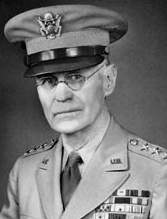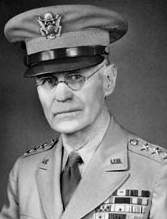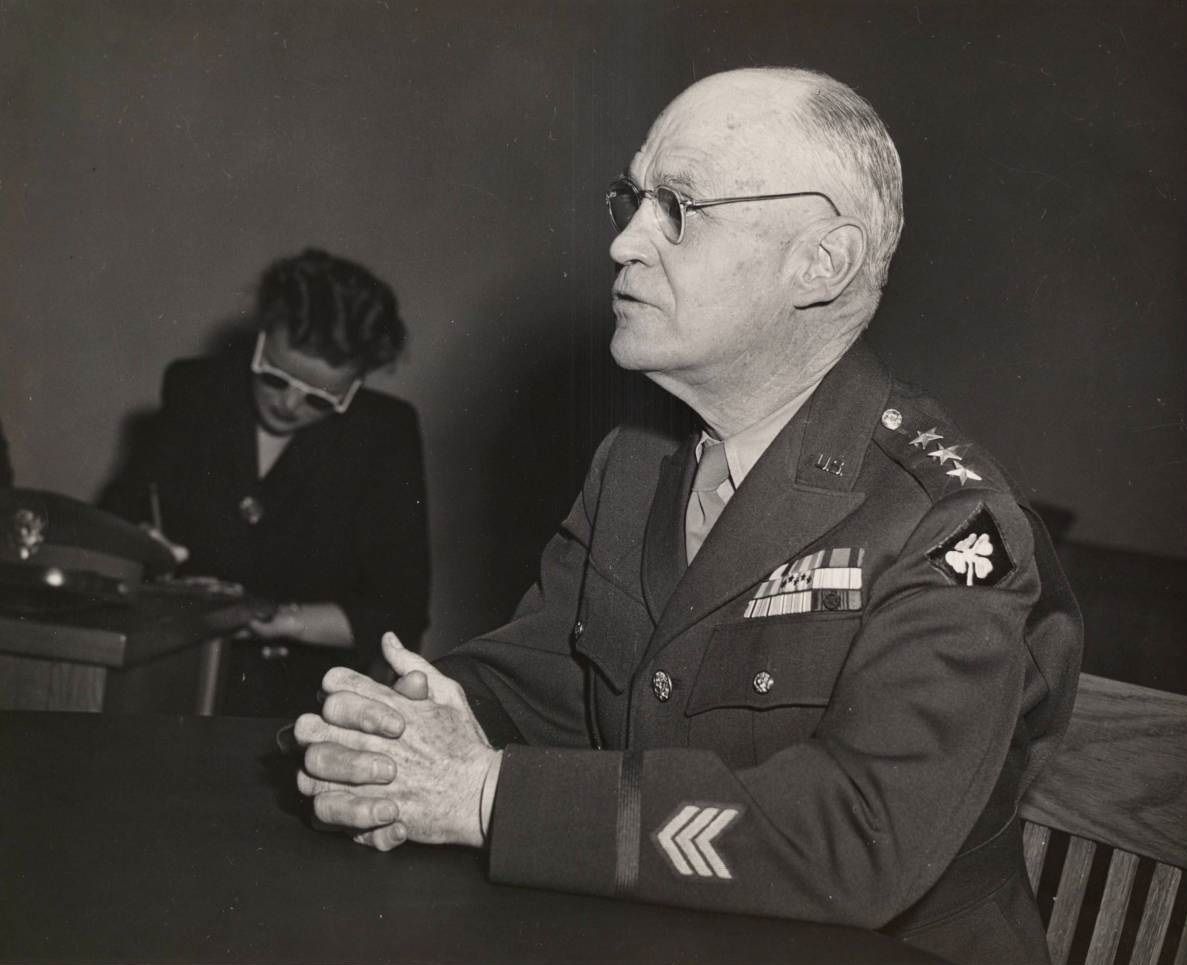As the commander of the Western Defense Command at the Presidio of San Francisco, California, in retrospect he is notoriously remembered for one of the worst discriminatory abuses of Constitutional civil liberties by the U.S. Government during the 20th Century, when he ordered the mandatory forced relocation of over 100,000 ethnic Japanese living on the US West Coast into internment camps, following the Japanese surprise attack on American naval, air and army installations at Pearl Harbor, Hawaii on December 7, 1941. At the time, anti-Japanese public sentiment was virtually unanimous and echoed by Washington politicians. There was little or no opposition to DeWitt's proposal, which seemed reasonable for the time.
Born at Fort Sidney, Nebraska, his father was a career US Army military officer as a surgeon who later became a brigadier general. In 1898 he was attending Princeton University at Princeton, New Jersey when the Spanish-American War broke out He left Princeton to enlist in the US Army and was appointed a 2nd lieutenant in the US Army Infantry. His early assignments include four tours in the Philippines, and he participation in the Philippine Insurrection. From 1914 until 1917 he was assigned to the Office of the Quartermaster General in Washington DC, during which time he also participated in the Mexican Punitive Expedition (also known as the Pancho Villa Expedition).
In 1918 he was sent to France with the 42nd Division and served as quartermaster, and promoted to the rank of colonel in July of that year. In 1919 he returned to the US and served in several different quartermaster positions, and promoted to the rank of brigadier general. In 1930 he was promoted to the rank of major general and became the Quartermaster General of the US Army and in 1934 he returned to the Philippines and became commander of the US Army Philippine Division. In July 1937 he returned to the US and became Commandant of the US Army War College at Carlisle Barracks, Pennsylvania. Two years later he was promoted to the rank of lieutenant general, commanding the 4th US Army and the Western Defense Command at the Presidio of San Francisco.
After the US declared war on Japan, he deemed all people of Japanese descent living on the West Coast to be a security risk and began making plans to classify, round up, and relocate them (regardless if they were US citizens or not) into internment camps, amid fears of further Japanese military attacks and potential sabotage. After convincing President Franklin D. Roosevelt of his plan, Roosevelt issued Executive Order 9066 and on March 23, 1942 the relocation efforts began.
In early 1943 he was in charge of Operation Landgrab, the military response to the Japanese invasion of the Aleutian Islands. Later in 1943 he became Commandant of the US Army and Navy Staff College (now the Joint Forces Staff College) in Washington DC (relocating to Norfolk, Virginia in 1946) and he retired in that position in 1947 with 49 years of continuous military service. Among his military and foreign awards and decorations include the Army Distinguished Service Medal (with one oak leaf cluster), the Navy Distinguished Service Medal, the Philippine Campaign Medal, the Mexican Service Medal, the World War I Victory Medal (with seven campaign clasps), the American Defense Service Medal (with one star), the American Campaign Medal, the Asiatic-Pacific Campaign Medal (with one campaign star), the World War II Victory Medal, and the French Legion of Honor. In July 1954 he was promoted to the rank of general by an Act of Congress for his services during World War II.
He died of a heart attack in Washington DC at the age of 82. His brothers, Calvin DeWitt, Jr. and Wallace DeWitt, became brigadier generals in the US Army.
A side note: It wasn't until 1988 that the US Government issued an official apology for the unjust treatment of Japanese-American citizens during World War II.
As the commander of the Western Defense Command at the Presidio of San Francisco, California, in retrospect he is notoriously remembered for one of the worst discriminatory abuses of Constitutional civil liberties by the U.S. Government during the 20th Century, when he ordered the mandatory forced relocation of over 100,000 ethnic Japanese living on the US West Coast into internment camps, following the Japanese surprise attack on American naval, air and army installations at Pearl Harbor, Hawaii on December 7, 1941. At the time, anti-Japanese public sentiment was virtually unanimous and echoed by Washington politicians. There was little or no opposition to DeWitt's proposal, which seemed reasonable for the time.
Born at Fort Sidney, Nebraska, his father was a career US Army military officer as a surgeon who later became a brigadier general. In 1898 he was attending Princeton University at Princeton, New Jersey when the Spanish-American War broke out He left Princeton to enlist in the US Army and was appointed a 2nd lieutenant in the US Army Infantry. His early assignments include four tours in the Philippines, and he participation in the Philippine Insurrection. From 1914 until 1917 he was assigned to the Office of the Quartermaster General in Washington DC, during which time he also participated in the Mexican Punitive Expedition (also known as the Pancho Villa Expedition).
In 1918 he was sent to France with the 42nd Division and served as quartermaster, and promoted to the rank of colonel in July of that year. In 1919 he returned to the US and served in several different quartermaster positions, and promoted to the rank of brigadier general. In 1930 he was promoted to the rank of major general and became the Quartermaster General of the US Army and in 1934 he returned to the Philippines and became commander of the US Army Philippine Division. In July 1937 he returned to the US and became Commandant of the US Army War College at Carlisle Barracks, Pennsylvania. Two years later he was promoted to the rank of lieutenant general, commanding the 4th US Army and the Western Defense Command at the Presidio of San Francisco.
After the US declared war on Japan, he deemed all people of Japanese descent living on the West Coast to be a security risk and began making plans to classify, round up, and relocate them (regardless if they were US citizens or not) into internment camps, amid fears of further Japanese military attacks and potential sabotage. After convincing President Franklin D. Roosevelt of his plan, Roosevelt issued Executive Order 9066 and on March 23, 1942 the relocation efforts began.
In early 1943 he was in charge of Operation Landgrab, the military response to the Japanese invasion of the Aleutian Islands. Later in 1943 he became Commandant of the US Army and Navy Staff College (now the Joint Forces Staff College) in Washington DC (relocating to Norfolk, Virginia in 1946) and he retired in that position in 1947 with 49 years of continuous military service. Among his military and foreign awards and decorations include the Army Distinguished Service Medal (with one oak leaf cluster), the Navy Distinguished Service Medal, the Philippine Campaign Medal, the Mexican Service Medal, the World War I Victory Medal (with seven campaign clasps), the American Defense Service Medal (with one star), the American Campaign Medal, the Asiatic-Pacific Campaign Medal (with one campaign star), the World War II Victory Medal, and the French Legion of Honor. In July 1954 he was promoted to the rank of general by an Act of Congress for his services during World War II.
He died of a heart attack in Washington DC at the age of 82. His brothers, Calvin DeWitt, Jr. and Wallace DeWitt, became brigadier generals in the US Army.
A side note: It wasn't until 1988 that the US Government issued an official apology for the unjust treatment of Japanese-American citizens during World War II.
Bio by: William Bjornstad
Family Members
Advertisement
See more DeWitt memorials in:
Advertisement













